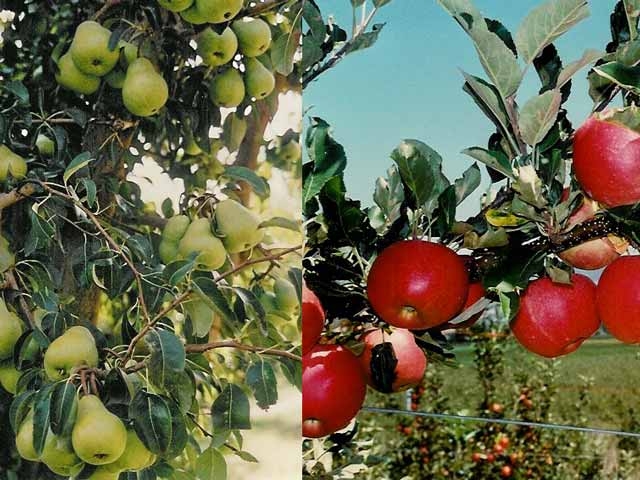The largest and best quality apples and pears grow on two-year-old wood and young spurs.
To develop two-year-old wood, prune trees according to the 1-2-3 rule of renewal pruning.
This rule ensures that the fruiting wood remains young and productive. Your trees are as young as the fruiting wood.
The 1-2-3 rule of renewal pruning is simple and less expensive than spur pruning, and it ensures that your trees do not develop old, tired spurs that produce fruit of poor quality and size.
This rule also avoids biennial bearing, provided there has been adequate cross-pollination.
The 1-2-3 rule is very effective if you keep your trees calm. Calm trees have dominant leaders that are not forked and have stubs and small secondary branches that carry the one, two, and three-year- old wood.
Using a pear tree as an example, here is how you use the 1-2-3 rule.
1 The 1 of the 1-2-3 rule refers to the one-year-old laterals, also called pencils.
These laterals are 300 to 400 mm long and a little thinner than a pencil.
The buds at the tips are often fruit buds (Figure 1). Never shorten these laterals. If you have too many, space them out and keep the ones that are horizontal and almost as thick as a pencil.
Remove the strong upright shoots and long laterals without fruit buds at the tips. These are nonproductive growth shoots. However, some pear varieties, such as Forelle and Beurre Bosc, often do not produce one-year-old laterals with fruit buds at the tips. If left untipped, these laterals will bud up in the second year.
Also remove the very thin laterals, because these will not produce the quality and sizes of fruit that the market wants.
About one-third of the renewal wood should be one year old.
If the laterals are much longer than 300 to 400 mm, your trees are excessively vigorous, and you must address this problem first. Here are some suggestions:
•Do not apply, or cut back on nitrogen fertiliser. Definitely no nitrogen fertiliser in spring.
•Prune more in summer, less in winter. Make thinning cuts instead of heading cuts. Let sunlight into your trees.
•Apply regulated deficit irrigation (RDI) if you can.
•Boost cross-pollination and fruit set by re-grafting whole trees, branch-grafting or inter-planting Chinese or Asian pear polliniser trees, i.e. Ya Li for Forelle, Hosui and Nijiseiki for d’Anjou and Packham, Nijiseiki for Bosc and Bartlett.
•Introduce five beehives per hectare at 5 percent full bloom. Hives must have young brood collecting mainly pollen. Place hives on fruit bins with hive openings to east-north (east-south for Northern Hemisphere).
•Mow weeds in the orchard to prevent them from flowering.
(On young, nonbearing Williams (Bartlett) and Forelle trees on Open Tatura with 2000 trees per hectare, we have used Ethrel (ethephon) sprays in mid and late summer to terminate extension growth of laterals.
This method of vigour control often resulted in laterals setting terminal fruit buds. Ethrel was sprayed [without a wetting agent] at the rate of 300 to 700 mL/ha three to five times. The differences in rates depended on the temperature in the orchard after spraying.
A low rate was used when it was hot, and a high rate when it was cool. The active constituent of Ethrel was 480 g/L of ethephon.)
2 The 2 in 1-2-3 refers to fruiting wood that is now two years old.
(cont next issue)
See this article in Tree Fruit April 2020






















